[English] 日本語
 Yorodumi
Yorodumi- PDB-4wx3: pore-forming thermostable direct hemolysin from Grimontia hollisae -
+ Open data
Open data
- Basic information
Basic information
| Entry | Database: PDB / ID: 4wx3 | ||||||
|---|---|---|---|---|---|---|---|
| Title | pore-forming thermostable direct hemolysin from Grimontia hollisae | ||||||
 Components Components | Hemolysin, heat labile | ||||||
 Keywords Keywords | TOXIN / thermostable direct hemolysin / TDH / tetramer / oligomeriation | ||||||
| Function / homology |  Function and homology information Function and homology informationsymbiont-mediated hemolysis of host erythrocyte / toxin activity / extracellular region Similarity search - Function | ||||||
| Biological species |  Grimontia hollisae (bacteria) Grimontia hollisae (bacteria) | ||||||
| Method |  X-RAY DIFFRACTION / X-RAY DIFFRACTION /  SYNCHROTRON / SYNCHROTRON /  MAD / Resolution: 1.701 Å MAD / Resolution: 1.701 Å | ||||||
 Authors Authors | Wang, Y.-K. / Wu, T.-K. / Li, T.-H.T. | ||||||
| Funding support |  Taiwan, 1items Taiwan, 1items
| ||||||
 Citation Citation |  Journal: To be published Journal: To be publishedTitle: Multiple pleomorphic tetramers of pore-forming thermostable direct hemolysin from Grimontia hollisae in exerting membrane binding and hemolytic activity Authors: Wang, Y.-K. / Huang, S.-C. / Huang, W.-T. / Chang, C.-Y. / Kuo, T.-M. / Yip, B.-S. / Wu, T.-K. / Li, T.-H.T. | ||||||
| History |
|
- Structure visualization
Structure visualization
| Structure viewer | Molecule:  Molmil Molmil Jmol/JSmol Jmol/JSmol |
|---|
- Downloads & links
Downloads & links
- Download
Download
| PDBx/mmCIF format |  4wx3.cif.gz 4wx3.cif.gz | 248.7 KB | Display |  PDBx/mmCIF format PDBx/mmCIF format |
|---|---|---|---|---|
| PDB format |  pdb4wx3.ent.gz pdb4wx3.ent.gz | 202.7 KB | Display |  PDB format PDB format |
| PDBx/mmJSON format |  4wx3.json.gz 4wx3.json.gz | Tree view |  PDBx/mmJSON format PDBx/mmJSON format | |
| Others |  Other downloads Other downloads |
-Validation report
| Summary document |  4wx3_validation.pdf.gz 4wx3_validation.pdf.gz | 441.6 KB | Display |  wwPDB validaton report wwPDB validaton report |
|---|---|---|---|---|
| Full document |  4wx3_full_validation.pdf.gz 4wx3_full_validation.pdf.gz | 442.2 KB | Display | |
| Data in XML |  4wx3_validation.xml.gz 4wx3_validation.xml.gz | 28.1 KB | Display | |
| Data in CIF |  4wx3_validation.cif.gz 4wx3_validation.cif.gz | 37.3 KB | Display | |
| Arichive directory |  https://data.pdbj.org/pub/pdb/validation_reports/wx/4wx3 https://data.pdbj.org/pub/pdb/validation_reports/wx/4wx3 ftp://data.pdbj.org/pub/pdb/validation_reports/wx/4wx3 ftp://data.pdbj.org/pub/pdb/validation_reports/wx/4wx3 | HTTPS FTP |
-Related structure data
- Links
Links
- Assembly
Assembly
| Deposited unit | 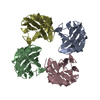
| ||||||||
|---|---|---|---|---|---|---|---|---|---|
| 1 |
| ||||||||
| Unit cell |
|
- Components
Components
| #1: Protein | Mass: 18643.596 Da / Num. of mol.: 4 Source method: isolated from a genetically manipulated source Source: (gene. exp.)  Grimontia hollisae (bacteria) / Plasmid: pCR2.1-TOPO / Details (production host): pCR2.1-TOPO / Production host: Grimontia hollisae (bacteria) / Plasmid: pCR2.1-TOPO / Details (production host): pCR2.1-TOPO / Production host:  #2: Water | ChemComp-HOH / | Has protein modification | Y | Sequence details | THE AUTHORS USED GRIMONTIA HOLLISAE STRAIN ATCC33564. THE AUTHORS ARE CONVINCED OF THIS SEQUENCE BY ...THE AUTHORS USED GRIMONTIA HOLLISAE STRAIN ATCC33564. THE AUTHORS ARE CONVINCED OF THIS SEQUENCE BY THE ELECTRON DENSITY MAP. | |
|---|
-Experimental details
-Experiment
| Experiment | Method:  X-RAY DIFFRACTION / Number of used crystals: 1 X-RAY DIFFRACTION / Number of used crystals: 1 |
|---|
- Sample preparation
Sample preparation
| Crystal | Density Matthews: 2.42 Å3/Da / Density % sol: 53.73 % / Description: thin flat plate |
|---|---|
| Crystal grow | Temperature: 298 K / Method: vapor diffusion, hanging drop / pH: 7.5 Details: 28%(v/v) PEG 400, 0.2 M CaCl2, 0.1 M Na-HEPES buffer |
-Data collection
| Diffraction | Mean temperature: 100 K | ||||||||||||
|---|---|---|---|---|---|---|---|---|---|---|---|---|---|
| Diffraction source | Source:  SYNCHROTRON / Site: SYNCHROTRON / Site:  NSRRC NSRRC  / Beamline: BL13B1 / Wavelength: 0.9789, 0.9790, 0.9639 / Beamline: BL13B1 / Wavelength: 0.9789, 0.9790, 0.9639 | ||||||||||||
| Detector | Type: ADSC QUANTUM 315r / Detector: CCD / Date: Jan 15, 2010 | ||||||||||||
| Radiation | Protocol: MAD / Monochromatic (M) / Laue (L): M / Scattering type: x-ray | ||||||||||||
| Radiation wavelength |
| ||||||||||||
| Reflection | Resolution: 1.7→30 Å / Num. obs: 73925 / % possible obs: 92.2 % / Observed criterion σ(F): 0 / Observed criterion σ(I): -3 / Redundancy: 4.9 % / Rmerge(I) obs: 0.064 / Rsym value: 0.064 / Net I/σ(I): 4.3 | ||||||||||||
| Reflection shell | Resolution: 1.7→1.76 Å / Redundancy: 4.1 % / Rmerge(I) obs: 0.57 / Mean I/σ(I) obs: 4.3 / % possible all: 79.3 |
-Phasing
| Phasing | Method:  MAD MAD |
|---|---|
| Phasing MAD | D res high: -0 Å / D res low: 0 Å / FOM : 0 / Reflection: 0 |
- Processing
Processing
| Software |
| ||||||||||||||||||||||||||||||||||||||||||||||||||||||||||||||||||||||||||||||||||||||||||||||||||
|---|---|---|---|---|---|---|---|---|---|---|---|---|---|---|---|---|---|---|---|---|---|---|---|---|---|---|---|---|---|---|---|---|---|---|---|---|---|---|---|---|---|---|---|---|---|---|---|---|---|---|---|---|---|---|---|---|---|---|---|---|---|---|---|---|---|---|---|---|---|---|---|---|---|---|---|---|---|---|---|---|---|---|---|---|---|---|---|---|---|---|---|---|---|---|---|---|---|---|---|
| Refinement | Method to determine structure:  MAD / Resolution: 1.701→23.848 Å / SU ML: 0.19 / Cross valid method: FREE R-VALUE / σ(F): 0 / Phase error: 31.5 / Stereochemistry target values: MLHL MAD / Resolution: 1.701→23.848 Å / SU ML: 0.19 / Cross valid method: FREE R-VALUE / σ(F): 0 / Phase error: 31.5 / Stereochemistry target values: MLHL
| ||||||||||||||||||||||||||||||||||||||||||||||||||||||||||||||||||||||||||||||||||||||||||||||||||
| Solvent computation | Shrinkage radii: 0.9 Å / VDW probe radii: 1.11 Å / Solvent model: FLAT BULK SOLVENT MODEL | ||||||||||||||||||||||||||||||||||||||||||||||||||||||||||||||||||||||||||||||||||||||||||||||||||
| Refinement step | Cycle: LAST / Resolution: 1.701→23.848 Å
| ||||||||||||||||||||||||||||||||||||||||||||||||||||||||||||||||||||||||||||||||||||||||||||||||||
| Refine LS restraints |
| ||||||||||||||||||||||||||||||||||||||||||||||||||||||||||||||||||||||||||||||||||||||||||||||||||
| LS refinement shell |
|
 Movie
Movie Controller
Controller




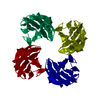
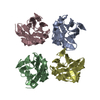

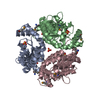
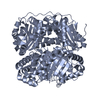
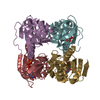
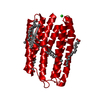
 PDBj
PDBj
